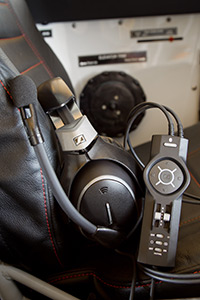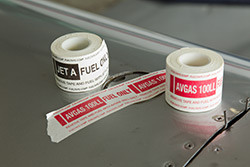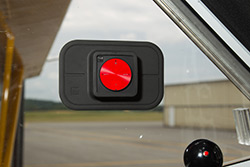Pilot Products:
Cool, new stuff
 Sennheiser S1
Sennheiser S1
Capitalists rejoice! More competition is among us. Sennheiser introduces a new headset this month: the top-end S1. With a price point squarely aimed at the Bose A20 and Lightspeed Zulu, Sennheiser thinks superior engineering will make it king of Headset Mountain.
The S1 is Sennheiser’s first big headset launch to the general aviation market in years, and the company made sure it had a good product before putting it all on the line. This thing is an engineer’s dream. It features multiple foam layers; the ear pads have a spot that’s softer where sunglass or eyeglass stems go; it has four microphones for optimal noise canceling; buttons provide a sound boost for those who have their audiologist on speed dial; Bluetooth is built in with controls for phone calls or music; tension on the band can be adjusted by the user. And then there’s The Button.
The Button is Sennheiser’s ace in the hole. Company representatives say that when a normal headset is engineered, a natural tradeoff occurs when trying to optimize the active noise reduction. That’s because ANR works by throwing back sound at the opposing wavelength, thereby canceling it out. But sounds in the cockpit change, and ANR is naturally only perfect for one frequency. Until The Button, that is.
Once a pilot presses The Button, the four microphones “listen” closely, the system does a bunch of work only German engineers understand, and then it reoptimizes the ANR for the current frequency level. This results in a quieter headset in all phases of flight. And believe it or not, reality matches marketing here. The headset becomes noticeably quieter every time you push The Button, be it for takeoff, cruise, descent, and so on.
Ironically, all of this button pushing is almost irrelevant because the S1 is quiet before the ANR is even turned on. That’s a strong selling point, especially considering how often batteries on ANR headsets die. Speaking of which, the two AA batteries will last anywhere from 25 to 40 hours on the S1, depending on which type and what functions are in use.
Sennheiser hopes its new S1 isn’t too late to the high-end ANR headset party. Regardless of timing, however, this is a strong performer and definitely worthy competition for Bose and Lightspeed.
Pros:
- Thoughtful features
- Quiet ANR and passive attenuation
- Bluetooth connectivity
Cons:
- Price
- Weight
Who: Sennheiser S1
What: Top-end active noise cancelling headset
Where: www.sennheiserusa.com; 860-434-1759
Why: More features than Bose A20 or Lightspeed Zulu
How much: $1,095; $995 introductory price
FuelTape
 One would think that with different-size fuel filler holes, different-size fuel nozzles on trucks—and different fuel colors and smells—aircraft misfueling would never happen. But that assumes a level of competence not seen on every ramp. FuelTape is yet another solution aimed at making sure only avgas goes into piston engines and jet fuel goes into turbine engines.
One would think that with different-size fuel filler holes, different-size fuel nozzles on trucks—and different fuel colors and smells—aircraft misfueling would never happen. But that assumes a level of competence not seen on every ramp. FuelTape is yet another solution aimed at making sure only avgas goes into piston engines and jet fuel goes into turbine engines.
Not unlike the color-coded stickers that surround fuel ports, FuelTape is a color-coded masking tape that goes over the fuel cap. The idea is that a lineman has to remove the tape to get the cap open, in the process hopefully noticing that it says in large letters, “Avgas 100LL Fuel Only” or “Jet A Fuel Only.” The tape comes in 30-foot rolls, which is enough for around 20 applications, assuming two fuel caps.
Although it does take a minute to apply, and you have to remember to actually do it, a little bit of time and effort seems a good trade-off for a misfueling accident.
Pros:
- Cheap insurance
- Visible, easy to use
Cons:
- Active system, must remember to use it
- May not stick well on wet wings
Who: FuelTape
What: Highly visible tape for fuel caps
Where: www.aircraftspruce.com; www.skygeek.com
Why: A minute is worth preventing an accident
How much: $8 to $10
 Dual GPS
Dual GPS
Apple's iPad might be the most talked-about cockpit accessory since the invention of aviator sunglasses, but there is no denying that it has its drawbacks. Chief among them is probably the built-in GPS, which isn't as accurate as a dedicated unit and has been known to come and go at certain altitudes.
Enter the Dual GPS. Like a few others on the market, the Dual GPS is a small, Bluetooth-enabled GPS that is meant to be paired with an iAnything. It also works with Android and PCs for the non-Apple fans among us.
The unit is required to be paired with a device before it starts searching for satellites. While this is a quick process, the satellite search is not. Our tests found it took almost three minutes for an initial lock, and around six minutes for a full, dedicated signal. We know this because we could track the satellite progress with the device's app that gives a current status with the number of locked-on satellites, as well as current latitude and longitude. Very cool.
The other strong selling point of this unit is its non-slip "carrying case." It's made of a soft, flexible material that will stay on any glareshield, or vertically on a window with no tape or suction. It's the little things.
Pros:
- Inexpensive
- App gives more status than just a light
- Supplied pad allows numerous mounting locations
Cons:
- Takes long time to lock on to satellites
- Yet another thing to remember to charge (eight hours battery life)
Who: Dual GPS
What: Small, Bluetooth GPS
Where: www.dualav.com
Why: Because your iPad needs a real GPS
How much: $99


